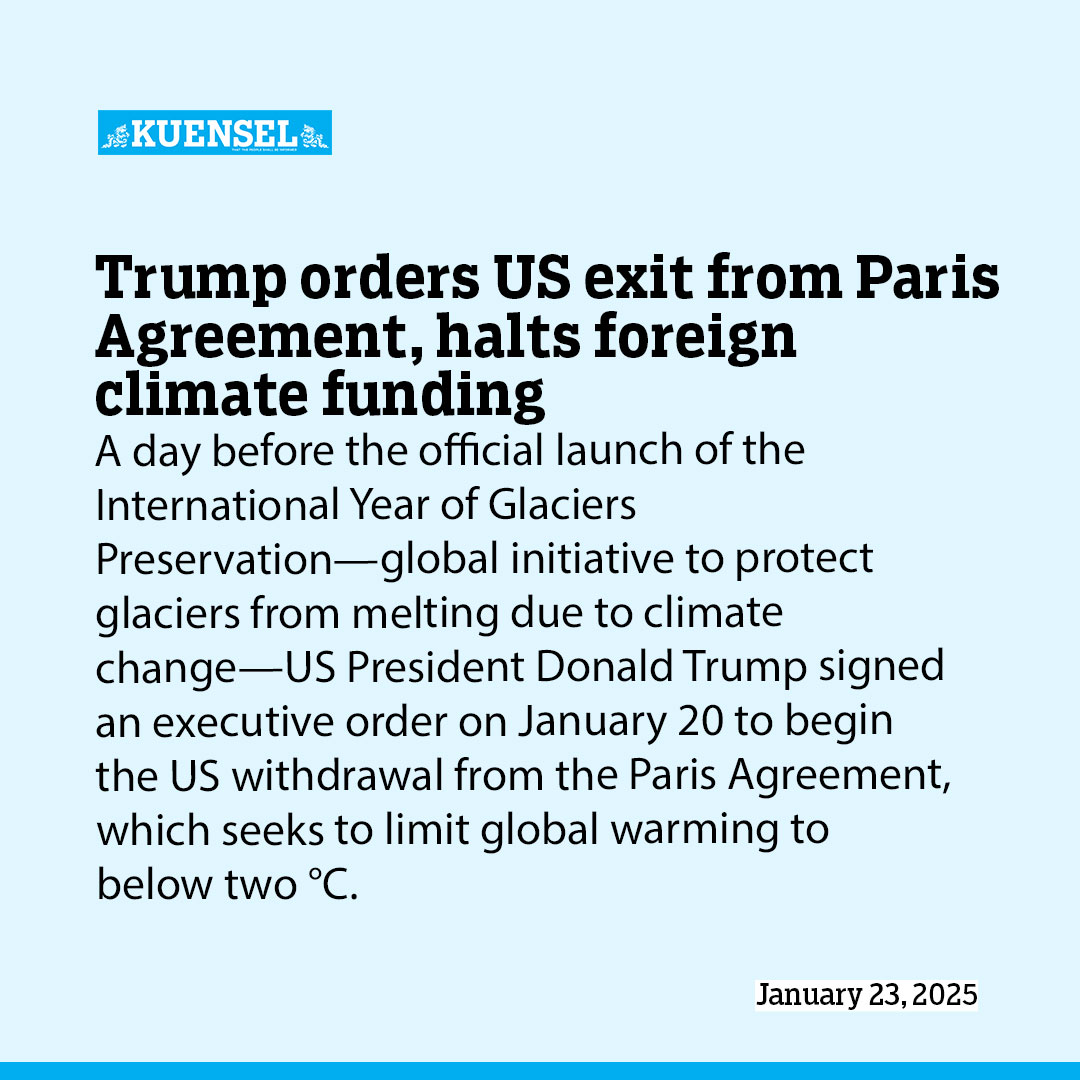…Developing countries like Bhutan depend on foreign climate financing to fulfil their climate commitments.
Yangyel Lhaden
A day before the official launch of the International Year of Glaciers Preservation—global initiative to protect glaciers from melting due to climate change—US President Donald Trump signed an executive order on January 20 to begin the US withdrawal from the Paris Agreement, which seeks to limit global warming to below two °C.
During the signing, Trump declared: “Drill, baby drill,” prioritising the expansion of oil and gas production—a stark contrast to global calls for urgent climate action.
The Paris Agreement, adopted in 2015, is a legally binding treaty under the United Nations Framework Convention on Climate Change (UNFCCC) aimed at combating climate change.
The UNFCCC provides the framework for addressing climate change and stabilising greenhouse gas concentrations.
Most countries are part of the Paris Agreement, but countries such as Iran, Libya, and Yemen remain outside it. The U.S. is currently in the process of withdrawing, which will make it one more country outside the agreement. This withdrawal process is expected to take at least one year.
This marks the second time the US, the world’s second-largest greenhouse gas emitter after China, has withdrawn from the Paris Agreement under Trump. He first withdrew in 2017, months after taking office, a move former president, Joe Biden, reversed on his first day in office in 2021.
What does US withdrawal mean?
The US is one of the largest contributors to the UNFCCC budget, accounting for about 20 percent of the total voluntary contributions. Under the Paris Agreement, developed countries like the US are mandated to provide financial support to developing nations for climate action, following the principle of “common but differentiated responsibilities.”
A portion of the UNFCCC budget supports funds like the Green Climate Fund, the Global Environment Facility, and the Adaptation Fund, which have provided Bhutan with resources to enhance its resilience to climate change.
Bhutan, a carbon-negative country committed to remaining carbon-neutral, has no role in global emissions yet suffers significant impacts of climate change. Securing external climate financing remains cumbersome, with lengthy processes delaying critical support.
The US withdrawal comes at a time when the Conference of Parties (COP) under the UNFCCC has repeatedly failed to meet the climate finance demands of vulnerable developing nations like Bhutan.
At COP29 last year, developing countries were left disappointed as developed nations refused to meet the demand for USD 1.3 trillion in annual climate financing for mitigation, adaptation, and loss and damage. Instead, the agreement settled on USD 300 billion annually, far short of what is needed.
“I am immediately withdrawing from the unfair, one-sided Paris climate accord rip-off,” Trump said while signing the executive order. “The United States will not sabotage our own industries while China pollutes with impunity.”
The executive order also declared that the US would “cease or revoke any purported financial commitment made by the United States under the UNFCCC.”
The 2017 withdrawal disrupted international climate diplomacy and damaged the US’s global credibility, signaling retreat from leadership on a critical issue. It also halted essential climate finance contributions, leaving developing nations without vital support, according to The Times, a London-based national newspaper.
Trump also declared a “national energy emergency” to reverse Biden-era environmental regulations and expand oil and gas exploration.
“America will be a manufacturing nation once again,” he said. “We have something no other manufacturing nation will ever have—the largest amount of oil and gas of any country on earth—and we are going to use it. We will use it. We will be a rich nation again, and it is that liquid gold under our feet that will help us do it.”
This decision to withdraw from the Paris Agreement and expand fossil fuel production by the US also comes at a time when greenhouse gas concentrations today is 40 percent higher than two decades ago and continue to rise.
The year 2024 was the warmest on record, according to the World Meteorological Organisation, and marked the first year the global average temperature exceeded 1.5 °C above pre-industrial levels.
This marks a significant milestone, highlighting the world’s failure to limit warming as agreed upon in the 2015 Paris Agreement, where member states committed to keeping global temperature rise well below two degrees Celsius and ideally limiting it to 1.5 °C.


